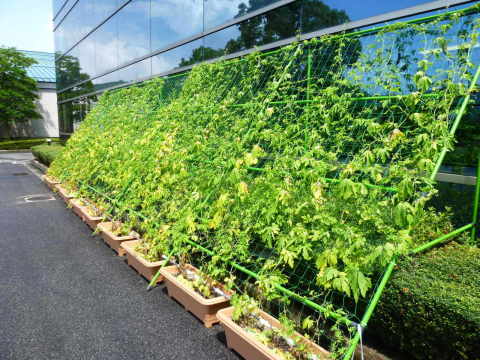KYOTO, Japan--(BUSINESS WIRE)--As part of its traditional environmental protection and sustainability activities, Kyocera Corporation (NYSE:KYO)(TOKYO:6971) plants Green Curtains every spring at its sites in Japan and select Kyocera Group companies in other parts of the world. Through the hot summer, curtains of foliage are grown on trellises in front of office windows and walls at company sites. This not only provides shade but also shields the buildings from heat radiation — decreasing inside room temperatures by approximately 3.6 degrees Fahrenheit*, which contributes to a reduction of energy consumption from air conditioner usage.
Furthermore, Green Curtains not only reduce the creation of, but also absorb CO2 emissions: one square meter of foliage absorbs approximately 7.7 lbs of CO2 per year. In 2012, Green Curtains grown by Kyocera stretched a length of 2,723 ft and an area of 36,780 ft2 — equivalent to the area of 13 tennis courts — helping to meet regional energy saving targets in Japan stemming from nuclear power plant stoppage in the wake of the 2011 earthquake and tsunami.
Since Kyocera first started growing Green Curtains at its Okaya Plant in the Japanese prefecture of Nagano in 2007, the company has expanded this activity to 28 sites in Japan and affiliates overseas including China, Thailand and Brazil. This year, Kyocera will also green its headquarters in Kyoto by growing morning glory vines outside the building and on the third-floor balcony.
On its Website about Green Curtain activities, Kyocera offers a comprehensive outline and explanation about this environmental initiative and encourages individuals and businesses to adopt the practice by publishing photos and illustrations which provide information on the necessary materials, and easily comprehensible instructions for making Green Curtains flourish at the workplace or at home. Furthermore, with the use of trellises, the foliage creates an attractive lush green and flowery decor on building facades, improving not only ecology, but also aesthetics.
Along with morning glory vines and goya, a traditional summer vegetable of the southern Okinawa Prefecture in Japan commonly known as bitter gourd, Kyocera cultivates cucumbers and peas as Green Curtains at its sites. After harvesting, these vegetables become delicious ingredients in special dishes served in employee cafeterias. Eating nutrient-rich bitter gourd helps to prevent fatigue in the hot summer season.
* Source: Japan Ministry of Land, Infrastructure, Transport and Tourism
For further information about the Green Curtain Activities:
http://global.kyocera.com/ecology/greencurtains/index.html
Kyocera Corporation (NYSE:KYO)(TOKYO:6971) (http://global.kyocera.com/), the parent and global headquarters of the Kyocera Group, was founded in 1959 as a producer of fine ceramics (also known as "advanced ceramics"). By combining these engineered materials with metals and integrating them with other technologies, Kyocera has become a leading supplier of solar power generating systems, mobile phones, printers, copiers, electronic components, semiconductor packages, cutting tools and industrial ceramics. During the year ended March 31, 2013, the company's net sales totaled 1.28 trillion yen (approx. USD13.6 billion). The company is ranked #492 on Forbes magazine's 2013 "Global 2000" listing of the world's largest publicly traded companies.




